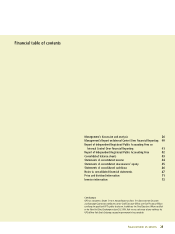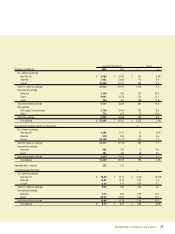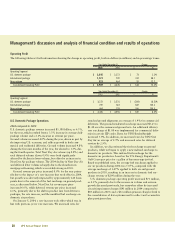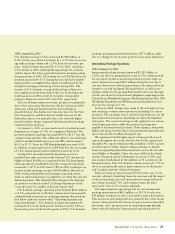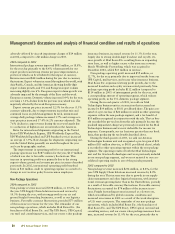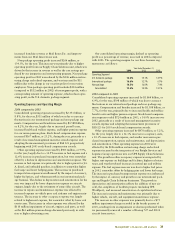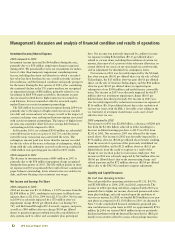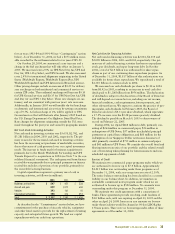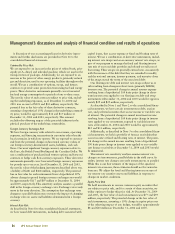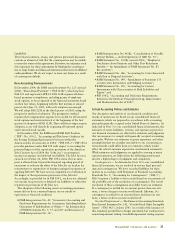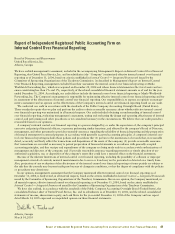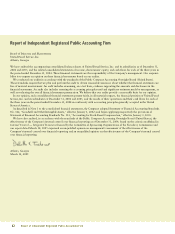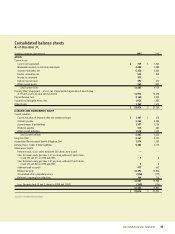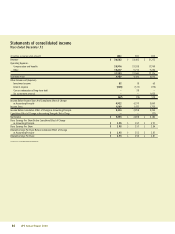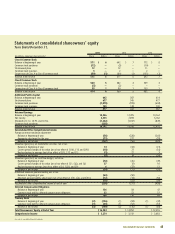UPS 2004 Annual Report Download - page 37
Download and view the complete annual report
Please find page 37 of the 2004 UPS annual report below. You can navigate through the pages in the report by either clicking on the pages listed below, or by using the keyword search tool below to find specific information within the annual report.
Management’s discussion and analysis 35
These twenty-three cases were consolidated for pre-trial pur-
poses in a multi-district litigation proceeding (“MDL
Proceeding”) in federal court in New York. In addition to the
cases in which UPS was named as a defendant, there also was an
action, Smith v. Mail Boxes Etc., against Mail Boxes Etc. and its
franchisees relating to UPS EV insurance and related services
purchased through Mail Boxes Etc. centers. That case also was
consolidated into the MDL Proceeding.
In late 2003, the parties reached a global settlement resolving
all claims and all cases in the MDL proceeding. In reaching the
settlement, we and the other defendants expressly denied any
and all liability. On July 30, 2004, the court issued an order
granting final approval to the substantive terms of the settle-
ment. No appeals were filed and the settlement became effective
on September 8, 2004.
Pursuant to the settlement, UPS has provided qualifying settle-
ment class members with vouchers toward the purchase of
specified UPS services and will pay the plaintiffs’ attorneys’ fees,
the total amount of which still remains to be determined by the
court. Other defendants have contributed to the costs of the settle-
ment, including the attorneys’ fees. The ultimate cost to us of the
proposed settlement will depend on a number of factors, including
how many vouchers settlement class members actually use. We do
not believe that this proposed settlement will have a material effect
on our financial condition, results of operations, or liquidity.
We are a defendant in a number of lawsuits filed in state
courts containing various class-action allegations under state
wage-and-hour laws. In one of these cases, Marlo v. UPS, which
has been certified as a class action in California state court,
plaintiffs allege that they improperly were denied overtime,
penalties for missed meal and rest periods, interest and attor-
neys’ fees. Plaintiffs purport to represent a class of 1,200
full-time supervisors.
We have denied any liability with respect to these claims and
intend to vigorously defend ourselves in these cases. At this time,
we have not determined the amount of any liability that may
result from these matters or whether such liability, if any, would
have a material adverse effect on our financial condition, results
of operations, or liquidity.
In addition, we are a defendant in various other lawsuits that
arose in the normal course of business. We believe that the even-
tual resolution of these cases will not have a material adverse
effect on our financial condition, results of operations, or liquidity.
We participate in a number of trustee-managed multi-
employer pension and health and welfare plans for employees
covered under collective bargaining agreements. Several factors
could result in potential funding deficiencies which could cause
us to make significantly higher future contributions to these
plans, including unfavorable investment performance, changes in
demographics, and increased benefits to participants. At this
time, we are unable to determine the amount of additional
future contributions, if any, or whether any material adverse
effect on our financial condition, results of operations, or cash
flows could result from our participation in these plans.
Due to the events of September 11, 2001, increased security
requirements for air carriers may be forthcoming; however, we
do not anticipate that such measures will have a material adverse
effect on our financial condition, results of operations, or liquid-
ity. In addition, our insurance premiums have risen and we have
taken several actions, including self-insuring certain risks, to mit-
igate the expense increase.
As of December 31, 2004, we had approximately 229,000
employees employed under a national master agreement and
various supplemental agreements with local unions affiliated
with the International Brotherhood of Teamsters (“Teamsters”).
These agreements run through July 31, 2008. The majority of
our pilots are employed under a collective bargaining agreement
with the Independent Pilots Association, which became amend-
able January 1, 2004. Negotiations are ongoing with the
assistance of the National Mediation Board. Our airline
mechanics are covered by a collective bargaining agreement
with Teamsters Local 2727, which becomes amendable on
November 1, 2006. In addition, the majority of our ground
mechanics who are not employed under agreements with the
Teamsters are employed under collective bargaining agreements
with the International Association of Machinists and Aerospace
Workers. These agreements run through July 31, 2009.
Market Risk
We are exposed to market risk from changes in certain commod-
ity prices, foreign currency exchange rates, interest rates, and
equity prices. All of these market risks arise in the normal course
of business, as we do not engage in speculative trading activities.
In order to manage the risk arising from these exposures, we uti-
lize a variety of foreign exchange, interest rate, equity and
commodity forward contracts, options, and swaps.
The following analysis provides quantitative information
regarding our exposure to commodity price risk, foreign cur-
rency exchange risk, interest rate risk, and equity price risk.
We utilize valuation models to evaluate the sensitivity of the fair
value of financial instruments with exposure to market risk that
assume instantaneous, parallel shifts in exchange rates, interest
rate yield curves, and commodity and equity prices. For options
and instruments with non-linear returns, models appropriate to
the instrument are utilized to determine the impact of market
shifts. There are certain limitations inherent in the sensitivity
analyses presented, primarily due to the assumption that
exchange rates change in a parallel fashion and that interest
rates change instantaneously. In addition, the analyses are
unable to reflect the complex market reactions that normally
would arise from the market shifts modeled.


